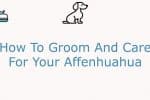Trimming Triumph: Mastering Nail Care for Your Dog
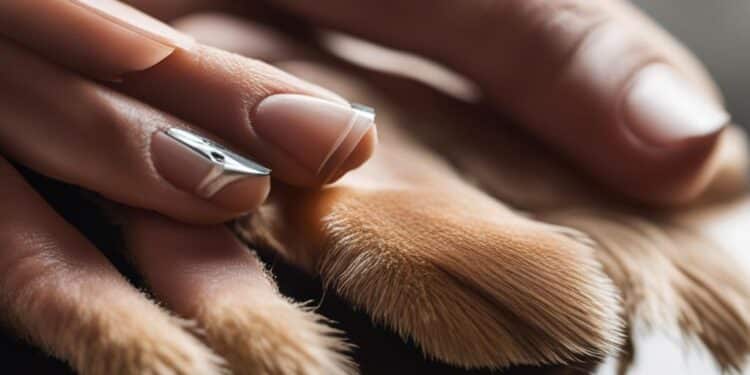
Your furry friend’s paw care should be an essential part of their grooming routine. Neglecting nail maintenance can lead to significant consequences impacting their overall health and mobility. Regular nail trims and maintenance can prevent discomfort, pain, and other medical issues. Therefore, it is crucial to learn proper nail trimming techniques and tips for accurate dog nail maintenance. Follow our expert nail trimming guide to ensure successful grooming sessions, and discover other alternative paw care options that can also promote healthy nail growth.
Learn how to prepare for successful nail trimming sessions, follow step-by-step guidance for accurate trims, handle common challenges, and avoid accidents during the process. Applying these Nail Trimming tips, Paw care, and Nail Trimming Guide practices will improve your dog’s comfort and health and bring you closer together as a team.
Understanding the Importance of Nail Maintenance
As a responsible pet owner, nail trimming should be an essential part of your dog’s grooming routine. Regular Nail Trimming is not just about aesthetics but also has a significant impact on your furry friend’s overall health and well-being. Neglecting maintenance can lead to a host of complications, including discomfort, pain, and even infections that can affect their mobility and quality of life.
Long nails can put unnecessary pressure on your dog’s paws and affect the way they walk, increasing the risk of joint and muscle problems in the long run. In some cases, untrimmed nails can also grow into the paw pads, leading to severe pain and potential surgery.
That’s why nail trimming and overall paw care must be performed regularly. These practices can ensure your dog’s proper mobility and an active lifestyle, promoting their happiness and healthy lifestyle.
Preparing for Successful Nail Trimming Sessions
Before you begin the nail trimming process, it’s essential to gather the necessary tools and supplies to ensure a smooth and safe grooming experience for both you and your dog. Here are the items you will need:
- Nail clippers designed for dogs
- Styptic powder
- Small treats to reward good behavior
- A comfortable and slip-resistant mat or surface
- A calming aid like lavender or chamomile if your dog becomes anxious during grooming
It’s also crucial to create a calm and relaxing environment for your dog to reduce anxiety during a nail trimming session. Turn off any distractions like loud music or TV, and make sure your dog is relaxed and comfortable before beginning. Consider using a calming aid or diffusing essential oils to help relax your dog.
When you’re ready to trim your dog’s nails, remember to take your time and stay calm and patient throughout the process. Use positive reinforcement and small treats as rewards for good behavior, and be sure to check for the quick (the blood vessel inside the nail) before trimming to prevent accidental injury.
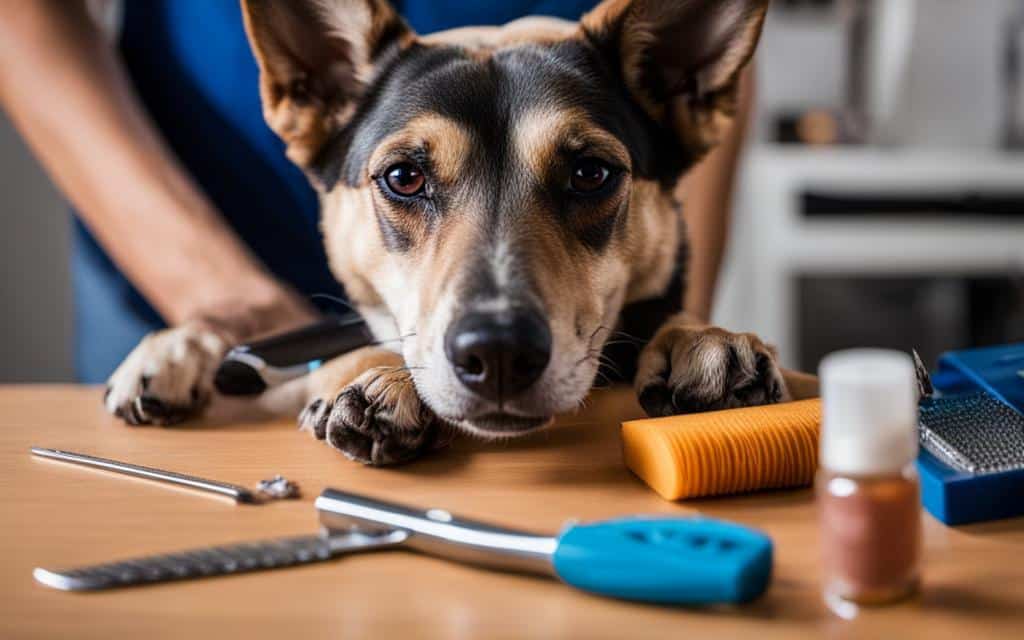
Nail trimming can be stressful for both you and your dog. Be sure to use calming aids and take breaks if needed to ensure a positive experience for all.
Step-by-Step Nail Trimming Technique
Trimming your dog’s nails can be a daunting task, but with the right technique, it can be a quick and easy process. Follow these step-by-step instructions to achieve a successful nail trimming session:
- Choose the Right Tool: Start by selecting the appropriate tool for your dog’s nails. Clippers, guillotines, and grinders are the most common options.
- Position Your Dog: Place your dog in a comfortable position, either seated or lying down. Make sure they are relaxed and calm.
- Locate the Quick: Identify the quick -the pink part of the nail that contains blood vessels and nerves -and avoid cutting it.
- Trim Gradually: Trim small sections gradually, starting from the tip of the nail and working your way back towards the quick.
- Use Treats: Use treats and positive reinforcement to encourage good behavior and reduce anxiety.
Using a Pet Nail Grinder
If you have opted for a pet nail grinder, follow these steps:
- Introduce the Grinder: Introduce the grinder to your dog, let them sniff and touch it, and reward them with praise and treats.
- Grind Gradually: Grind the nail gradually, in a smooth and circular motion, avoiding the quick. Keep the sessions brief, under two seconds.
- Ease into it: If your dog is unsure or anxious about the grinder, introduce it gradually over a few sessions.
With practice, you’ll become more confident in your nail trimming skills, and your dog will become more comfortable with the process, making it a stress-free experience for both of you.
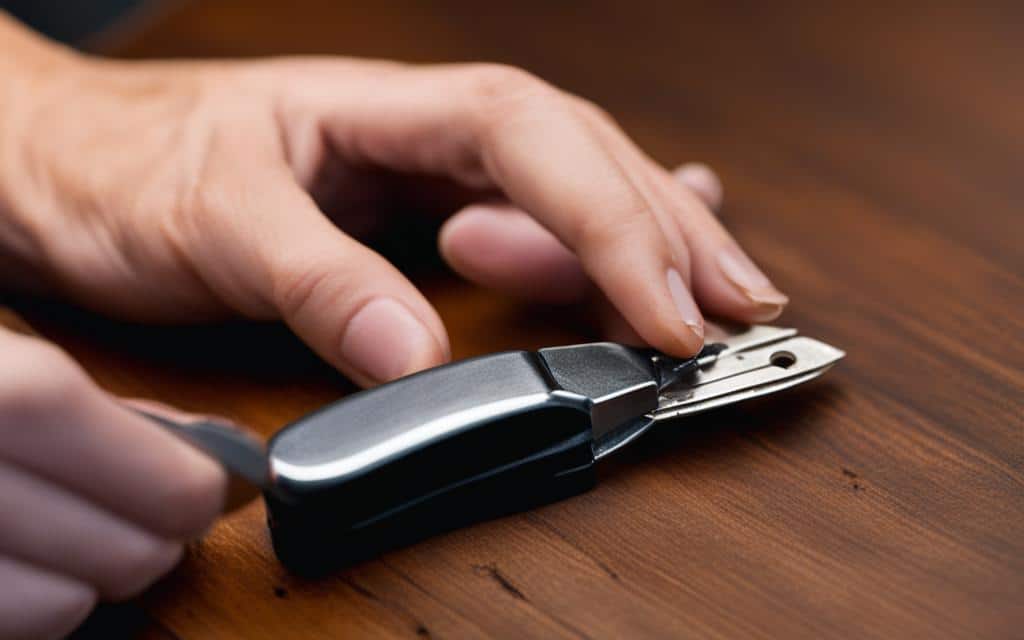
Tips for Handling Nail Trimming Challenges
Despite your best efforts, nail trimming can sometimes be stressful for dogs and their owners. In this section, we will explore common challenges that may arise during nail trimming and provide effective strategies to overcome them.
Resistant Dogs
Some dogs may resist nail trimming due to fear, anxiety, or previous negative experiences. To make the process less intimidating, try desensitizing your dog to the tools beforehand. Start by handling their paws and gradually introduce the clippers or grinder. Reward positive behavior with treats and praise to build trust and confidence.
Dark Nails
Trimming dark nails can be challenging, as it’s difficult to see the quick, the sensitive part of the nail that can cause bleeding if cut. To avoid this, consider using a grinder or filing the nails in small increments until you see a white, powdery ring around the edge of the nail. This indicates that you’re close to the quick and should stop trimming.
Accidental Bleeding
If you accidentally cut the quick and your dog’s nail starts bleeding, don’t panic. Apply pressure to the nail with a clean cloth or cotton ball, and use styptic powder or cornstarch to help stop the bleeding. Be sure to reward your dog with a treat and praise for their cooperation during the process.
Expert Tip: When in doubt, enlist the help of a professional groomer or veterinarian. They can provide guidance and support to ensure a stress-free and safe nail trimming experience.
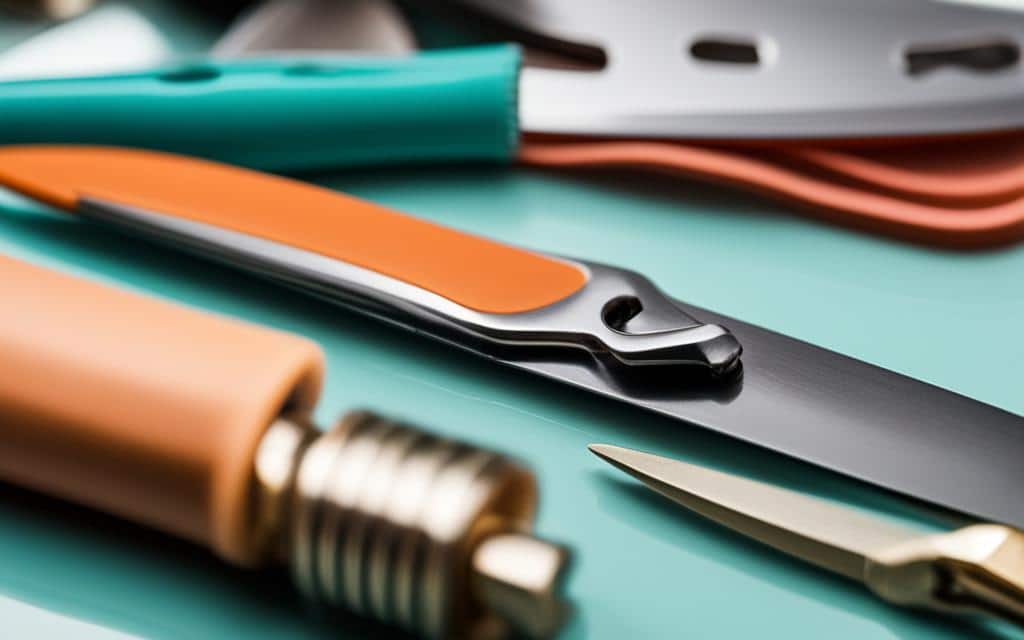
Continue reading to learn essential safety measures for nail trimming to avoid accidents and injuries.
Safety Measures and Avoiding Accidents
Trimming your dog’s nails is an essential part of their paw care routine, but it can be nerve-wracking for both you and your furry friend. To avoid accidents and ensure a safe grooming experience, there are several crucial safety measures you should follow.
Avoiding the Quick
The quick is the pink area inside your dog’s nail that contains blood vessels and nerves. Cutting the quick can be painful for your dog and cause bleeding, so it’s essential to avoid it while trimming their nails. If your pet has light-colored nails, the quick is visible as a pink area; for dark nails, it may be more challenging to locate. Start by trimming a small section of the nail and gradually working your way towards the tip, stopping when you see a black dot in the center of the nail, which indicates you’re nearing the quick.
Using the Right Tools
Using the appropriate tools is also crucial for a safe nail trimming experience. A sharp pair of clippers designed specifically for your dog’s nail size is essential. Dull clippers can crush the nail and cause splintering, while too-small clippers can cut into the quick. Additionally, a styptic powder or pencil can help stop bleeding if the quick is accidentally cut.
Ensuring Proper Nail Length
Keeping your dog’s nails at an appropriate length is critical for their paw health and can prevent injuries, such as snagging or breaking. However, cutting their nails too short can be painful and increase the risk of infection. Aim to cut just the tips of their nails, avoiding the quick, and be cautious with older or debilitated pets who may have weaker nails.
Expert Tip: For anxious or uncooperative pets, it may be safer to have a professional groomer or veterinarian trim their nails to avoid any unnecessary risk of injury.
By following these safety measures and taking the necessary precautions, you can trim your dog’s nails with confidence, ensuring a stress-free and safe paw care routine.
Alternative Nail Care Options
While nail trimming is the most common method of maintaining your dog’s nails, there are alternative options to consider for optimal paw care. Filing and grinding are two techniques that offer an alternative to clipping. These methods require specific tools, but with practice, you can easily incorporate them into your grooming routine.
Filing
Filing is a popular choice for dogs that are afraid of clippers and other cutting tools. This method involves using a nail file or Dremel tool to gradually reduce the length of the nail. To file your dog’s nails, follow these simple steps:
- Choose a high-quality nail file or Dremel tool designed for dogs.
- Secure your dog and position their paw so you can access the nail easily.
- Gradually file the nail down, being careful not to go too far.
- Repeat on the other nails, following the same process.
Grinding
Grinding is another option to consider for maintaining your dog’s nails. This technique uses a specialized tool to grind down the nail, rather than clipping it. Grinders are great for dogs with thick or hard nails, or if you don’t feel comfortable using clippers. Follow these steps to grind your dog’s nails:
- Select a high-quality grinder that’s appropriate for your dog’s size and nail thickness.
- Prepare your dog and position their paw for easy access.
- Gradually grind each nail down, being careful not to apply too much pressure.
- Repeat the process on each nail until they’re at the desired length.
Remember, filing and grinding your dog’s nails require specific tools and may take some time to get used to. Always ensure the safety of your pet and take it slow when trying something new.
Professional Nail Trimming Services
While nail trimming can be a straightforward task, some dogs may require extra attention and care. In such cases, seeking professional nail trimming services can be the best solution.
Professional groomers or veterinarians have the experience and knowledge to handle various nail trimming challenges, from overgrown nails to aggressive behavior. They also have specialized tools and equipment that can make the task easier and safer for your pet.
If you are uncertain about how to safely trim your dog’s nails or encounter difficulties during the grooming process, it’s wise to seek professional help. By entrusting this task to trained experts, you can ensure your dog receives optimal paw care without the risk of accidents or injuries.
In addition, professional nail trimming sessions can be an excellent opportunity to detect any underlying paw health issues, such as infections, cysts, or ingrown nails. Your groomer or veterinarian can advise you on how to treat these issues and prevent them from recurring in the future.
Investing in professional nail trimming services can also simplify your pet care routine and provide you with peace of mind. By leaving this task to the experts, you can focus on other aspects of your dog’s health and well-being, knowing their paw care is in good hands.
Conclusion
Congratulations on completing this comprehensive nail trimming guide for your furry friend. We hope this article has provided you with valuable insights and tips to make nail care a stress-free experience for both you and your pet. Remember, regular nail maintenance is crucial for your dog’s overall health and well-being.
By following the tips and techniques outlined in this guide, you can ensure that your dog’s nails remain healthy and well-maintained. Don’t hesitate to seek professional nail trimming services if you feel uncomfortable or unsure about performing the task yourself.
Thank you for reading this nail trimming guide, we hope it has been helpful in your journey towards becoming a responsible and attentive pet owner. Keep practicing and refining your techniques, and you’ll be a pro at nail trimming in no time!
FAQ
Why is nail maintenance important for dogs?
Regular nail maintenance is crucial for a dog’s overall health and well-being. Overgrown nails can cause discomfort, pain, and even affect their ability to walk and run properly.
How often should I trim my dog’s nails?
The frequency of nail trimming depends on your dog’s activity level and lifestyle. In general, it is recommended to trim your dog’s nails every 4 to 6 weeks. However, some dogs may require more frequent trimming, while others may need less.
What tools do I need for nail trimming?
To trim your dog’s nails, you will need a pair of high-quality dog nail clippers or a nail grinder, styptic powder to stop bleeding in case of accidental cuts, and treats for positive reinforcement.
How can I make my dog feel comfortable during nail trimming?
Creating a calm and comfortable environment is essential for successful nail trimming. Introduce your dog to the tools gradually, reward them with treats and praise, and be patient and gentle throughout the process.
What is the quick and how do I avoid cutting it?
The quick is a blood vessel that runs inside the nail. Cutting into the quick can cause bleeding and pain. To avoid cutting it, only trim the tip of the nail, be cautious with dark-colored nails, and consider using a nail grinder for better precision.
What should I do if my dog’s nails are too long?
If your dog’s nails are too long, it is best to gradually trim them in small increments over several weeks. Cutting too much at once can be painful for your dog and may cause bleeding. Seek the assistance of a professional groomer if needed.
Can I file or grind my dog’s nails instead of trimming?
Yes, filing or grinding your dog’s nails can be an alternative to traditional trimming. It helps smoothen the edges and may be useful for dogs with sensitive paws. However, it is essential to use appropriate tools and techniques to avoid discomfort or injury.
When should I consider professional nail trimming services?
You may consider professional nail trimming services if you are uncomfortable or unsure about trimming your dog’s nails yourself. It can also be beneficial if your dog has extremely difficult nails, or if you prefer to leave this task to experienced groomers.
What are the benefits of maintaining my dog’s paw health?
Maintaining your dog’s paw health is essential for their overall comfort and mobility. Regular nail maintenance helps prevent nail overgrowth, split nails, ingrown nails, and other paw-related issues that can affect their quality of life.

